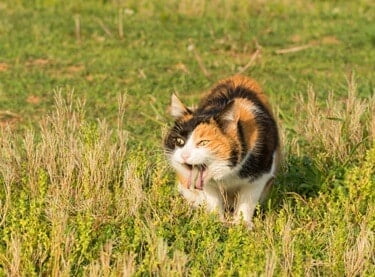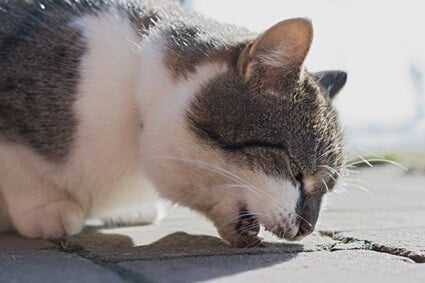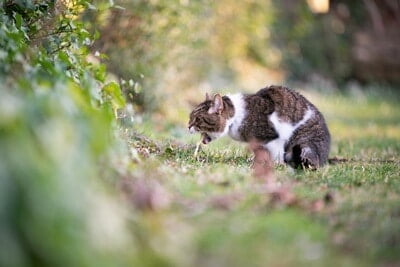Cats vomit regularly, but it’s concerning when they bring up undigested food. Vomiting and regurgitation are different: vomiting is from the stomach, while regurgitation is from the throat. Cats vomit after eating due to excessive consumption or eating too quickly.
Cats should be fed less food and given time to rest after a meal. Feed the cat wet food, not dry food, as it won’t swell up in the stomach. Avoid cold food as it’ll be harder to digest. Increase the cat’s fiber intake to clear small intestinal blockages, and get a RAST test to check for allergies.
Always feed your cat appropriate portion sizes, don’t change its food, and serve its meals at room temperature. Offer fresh drinking water and ensure this is available in different locations.
Cat Regurgitation vs. Cat Vomiting
Vomiting and regurgitation are terms that are used interchangeably. However, there are differences.
Regurgitation
Feline regurgitation is a sudden and unexpected event. Your cat will open its mouth, and undigested food will emerge. There will be no symptoms, so you won’t receive any warning.
Regurgitation happens in the throat as your cat is expelling food because it cannot swallow. This means that the food hasn’t made it to the stomach, so regurgitated food often takes the shape of a long tube.
Vomiting
Vomiting occurs when the contents of a cat’s stomach are expelled. The digestive tract is rejecting the food, so the stomach will contract, leading to discomfort, which is why cats heave before vomiting.
Vomiting is an everyday occurrence for cats, but regurgitation isn’t. If your cat is regurgitating food, seek advice from a vet. Vomiting, while still unpleasant, is less concerning.
What Causes Cats to Bring Up Food?
If your cat is regurgitating food, an obstructed esophagus will be to blame.
Explanations for this include:
- Esophagitis (inflammation of the esophagus)
- Megaesophagus (enlargement of the esophagus)
- Addison’s disease
- Consumption of toxins
- Neuromuscular disorder
- Hypothyroidism
Why Is My Cat Throwing Up After Eating?
There are many reasons why a cat may vomit after eating, including:
- Eating to excess
- Eating too quickly
- Change of diet
- Moving after eating
- Cold food
- Allergies
- Gastrointestinal issues
Eating Too Much
Cats eating to excess is a common explanation for vomiting.
Cats can often eat beyond the point of fullness (polyphagia) for the following reasons:
- Stress
- Diabetes
- Hypertension
- Side effects of medication
- Pregnancy
- Pancreatic issues
Your cat may be greedy, as many cats take pleasure from food consumption.
You’ll need to moderate your cat’s food intake. The average adult cat will require 240 calories per day, but senior cats and less active cats will burn fewer calories.
Eating Too Fast
Some cats eat faster than their bodies can handle, which is a problem with dry food, which expands in a cat’s stomach. Your cat will eat rapidly and expel the food when pressure is placed on the digestive tract.
The main reason for cats eating too quickly is food anxiety. The cat is concerned that it won’t get to eat if it doesn’t eat fast. This may arise if the cat has an inconsistent food routine or shares food with other pets.
If you have more than one cat, give each cat its own bowl and feed them in separate areas. Maintain a strict schedule. Ensure that your cat understands that it’ll always be fed at a specific time each day.
If this doesn’t help, break up your cat’s feeding routine. Feed your cat half as much, twice as often. Alternatively, get a slow-feeding bowl as they contain ridges that will slow your cat down.

Eating Unfamiliar Food
If you have changed your cat’s diet, vomiting may follow. Cats have very sensitive stomachs, and any sudden dietary changes will upset a cat’s digestion.
Switching between wet and dry food has a significant impact. Even changing a brand of wet food can cause problems. Consequently, any dietary changes need to be made gradually.
Start by mixing the new food with the familiar food. This ratio should be 90% old and 10% new. Over the course of the next 2 weeks, steadily increase the percentage of new food.
Moving After Eating
Cats need to rest after eating as too much movement will upset their stomach.
The best way to manage this is with a strict schedule. Play with your cat before feeding time, as this will leave your cat tired. Once your cat has eaten, it’ll likely groom itself and fall asleep.
If your cat wants to play or explore after eating, vomiting is more likely. The cat will run and jump, upsetting its stomach, and any food yet to be digested will be expelled.
Food Is Too Cold
Never feed a cat food straight from the refrigerator as it’ll be more difficult for cats to digest.
When a cat eats, it seeks to replicate the experience of hunting. Live prey has a body temperature that matches a cat, but this won’t be the case with chilled food.
Cats’ stomachs cannot easily digest cold food, which means the meal will be expelled. Allow the food to reach room temperature before serving.
You could microwave the food for a few seconds, but don’t allow it to overheat.
Allergic To Food Ingredients
Cats can develop food allergies at any stage of life. Food that was OK can suddenly make a cat feel unwell, seemingly without warning.
Vomiting suggests that an ingredient in the meal is to blame. As the Journal of Veterinary Internal Medicine explains, you’ll need to check the food ingredients and source alternatives.
Perhaps your cat has developed an allergy to its bowl as plastic allergies are common. Serve your cat’s meal on a cardboard or china plate. If this stops your cat from vomiting, the vessel was the problem.
Gastrointestinal Issues
Your cat may have developed a gastrointestinal issue, which can happen at any point in your cat’s life.
Examples include:
- Irritable bowel syndrome
- Intestinal parasites (i.e. tapeworm or roundworm)
- Intestinal blockages due to hairballs or swallowed foreign objects
- Cancerous tumors in the stomach
Increase the fiber in your cat’s diet as this will flush out any minor blockages. Also, rub Vaseline on your cat’s paws. Your cat will lick its paws, and the Vaseline will lubricate the digestive tract.
A vet can take blood and urine samples to reveal any medical concerns and intestinal blockages.
Dry Food vs. Wet Food
Dry food is more likely to cause vomiting than wet food, especially if your cat has a sensitive stomach.
That’s due to the following reasons:
- Dry food takes longer to break down in the stomach
- Dry food can be high in grain
- Dry food cannot circumvent minor stomach blockages
- Dry food expands in the stomach
As cats age, wet food is a better core food, but small amounts of kibble are fine.
Dry food takes a long time to break down and will sit heavy in a cat’s stomach, which means the cat may vomit if it moves or drinks water. Wet food can also slip past blockages, such as hairballs, but dry food can’t circumvent these obstacles.
As dry food expands in the stomach, it can double in size. A cat that eats quickly will struggle with this problem. The cat won’t realize it has eaten its fill, so the stomach will expel any excess food.

What to Do After a Cat Vomits
Your cat will likely consider itself to be OK after vomiting. If you act concerned, your cat will sense your anxiety and become worried about vomiting.
After a vomiting episode, a cat should fast for 12 hours, which will settle its stomach. Once the fast is complete, offer your cat some bland food.
Chicken and rice is the perfect meal. Within 24 hours, return your cat’s diet to normal, encouraging it to drink water in between, not during, meals.
My Cat Will Not Eat After Vomiting
Most cats would behave normally after vomiting unless the vomiting were painful or frightening. Your cat may associate food with these negative experiences.
Ways to encourage a cat to eat include:
- Serving food with a strong scent, such as seafood
- Offer meat-based baby food
- Pour meaty broth or tuna juice over food
Encouraging a cat to eat can be a slow process as your cat needs to build trust in its food again yet needs to eat some food within 24 hours.
Should I See a Vet About My Cat’s Vomiting?
Consult a vet if your cat continues to vomit a second day, as this condition is known as acute vomiting. Brown vomit in cats is also concerning as it suggests that the cat may be bleeding internally.
Assist your vet by observing and noting any behaviors, which will help a vet make an accurate diagnosis.
Concerning behaviors include:
- Lethargy and depression
- Loss of appetite and associated weight loss
- Refusal to drink water
- Traces of blood in the vomit
- Struggling to eliminate or urinate
- Swelling around the abdomen
- Foul breath
- Loss of interest in grooming
The best way to treat regurgitation in cats at home is fasting. If your cat hasn’t eaten, it’ll have nothing to bring up. Allow a cat to fast for up to 12 hours before offering it a bland meal.


Dah, but the question was about vomiting several hours (5) after eating. A cat has appetite, but no matter what it eats it vomits hours later. Dry food always causes vomiting, faster than wet food. Won’t touch some Wet food but will eat another only to refuse the latter next time. Vet took blood and all was normal. Could not get urine for some reason. Does it drink water? I don’t know. Water bowls are everywhere. It pees and urine is very dark. No stool for a week. The cat is 14 years Manx. She is almost skeletal and I am not sure why she is still alive, but after nearly dying she bounces back for a short while only to eat, get sick, rest for hours nearly motionless. She is an indoor cat, but maybe this is an infection of some sort? IVs , x-rays are out of the question. I had to borrow money to take her to the vet. I’m disabled and homebound.